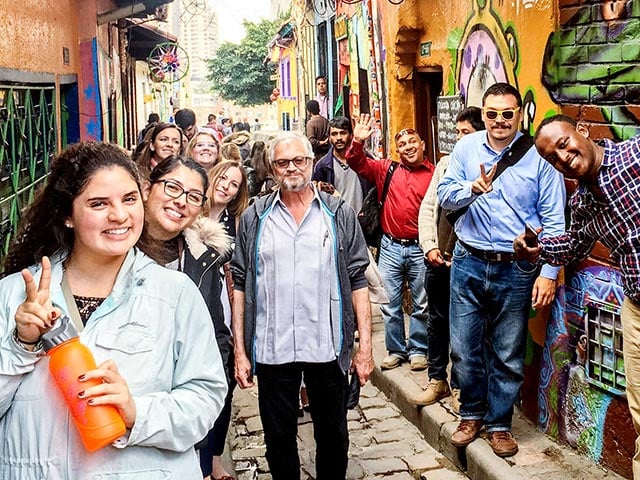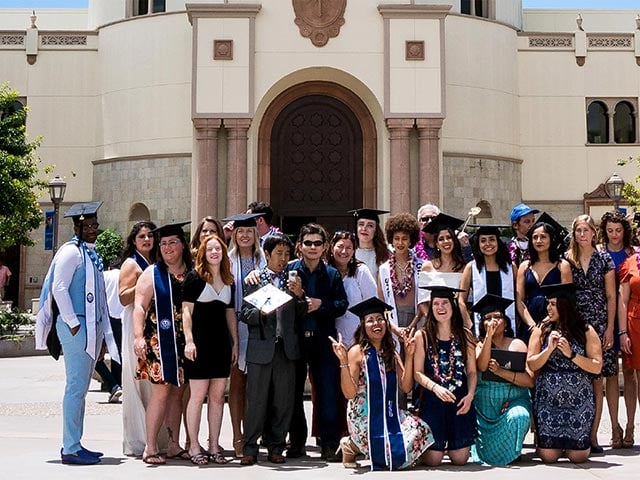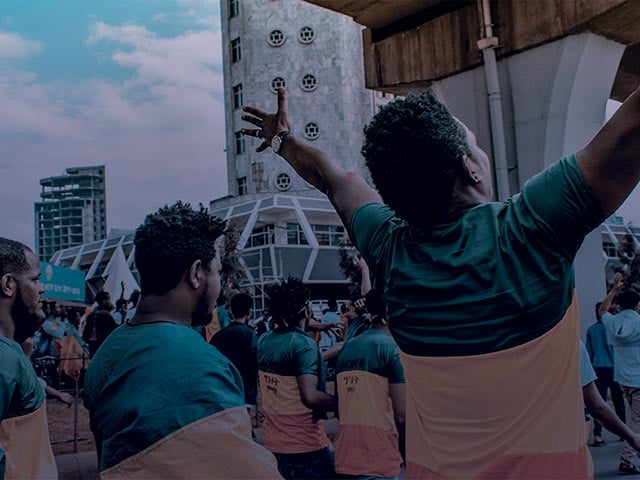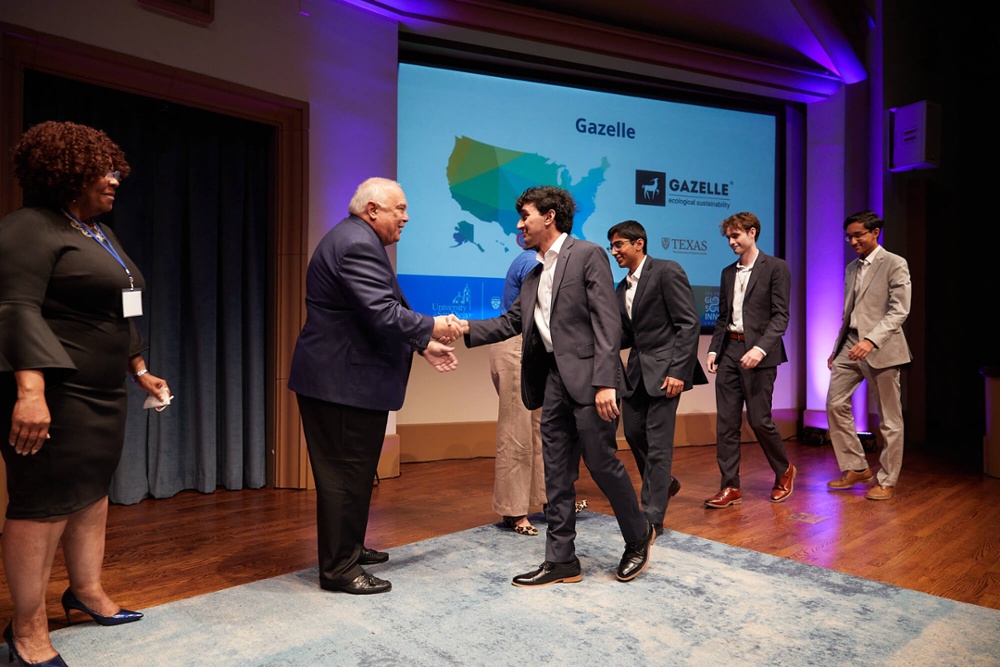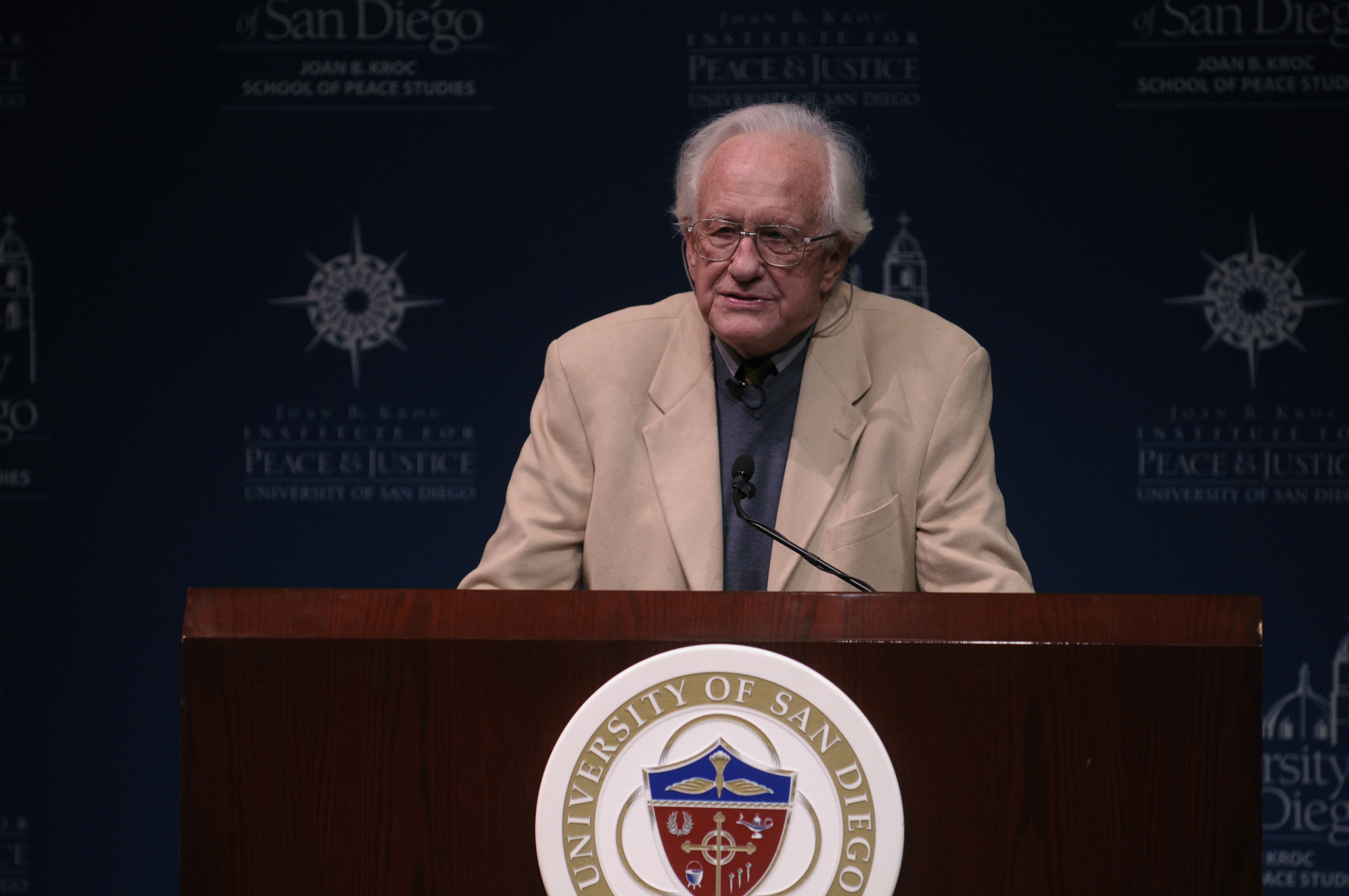Johan Galtung, often referred to as one of the founding fathers of Peace Studies, died on the 17th of February. His passing serves as an occasion for us at the Kroc School to reflect not on his broader legacy per se (there are many better-placed to do that), but on its intersection with the Kroc School’s own institutional development, ethos, identity, and trajectory.
Prof. Galtung visited the Kroc School in 2010 as a speaker for our Distinguished Lecture Series (watch here). At the time of his visit – three years after the Kroc School’s founding, two after it hired its very first faculty member – Kroc was tiny. We had a teaching faculty of four and one other professor of practice. We had perhaps 15 - 20 students. Our presence barely registered in the large building bequeathed to the University of San Diego to house us.
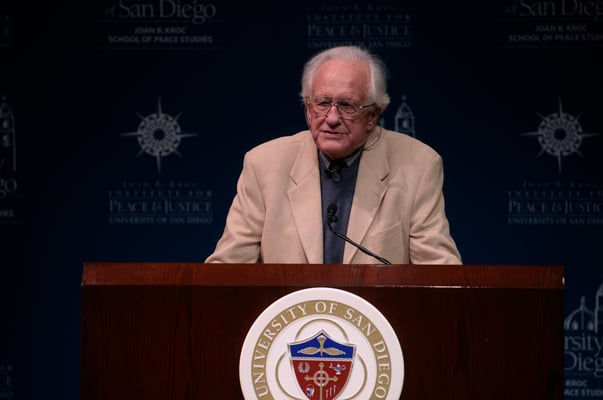 Johan Galtung speaking in 2010 at the Kroc Institute for Peace and Justice Distinguished Lecture Series
Johan Galtung speaking in 2010 at the Kroc Institute for Peace and Justice Distinguished Lecture Series
More importantly, the Kroc School had a weak collective identity with respect to the broader field. The School did not emerge organically from a historical culture of social justice and anti-war activism, as Peace Studies has done at, say, UC Berkeley or Quaker schools like Swarthmore. Rather, it was founded by way of bequest at a Catholic liberal arts university with no prior experience of peace studies. The hiring strategy was drawn up by external experts. The idea was to start with one each of four “foundational” specialties: conflict resolution, development, human rights, and human security. Until the hire of Professor Necla Tshirgi (for “human security”), none of the respective hires knew much about the broader field or how we were to cohere. We each brought our own fields’ disjointed methods, objects of study, and philosophical underpinnings from without.
Though we perhaps didn’t appreciate it at the time, these types of formulaic recipes for Peace Studies (1 part development, 1 part human rights…) borrowed tremendously from Galtung’s own pioneering thought. Indeed, even the title of our introductory Foundations course implied that the House of Peace was an edifice to be engineered. Galtung’s structuralist approach to Peace Studies famously posited that negative peace – the absence of direct violence – might be enforced via coercive institutional structures. But positive peace would describe the presence of those attributes – justice, opportunity, security, liberty – that would render violence unnecessary in the first place. Humanity could, with rationality and analysis and diligence, craft sets of local, national, and international institutions collectively capable of guaranteeing those attributes and thereby banishing violence. His vision of developing a positive “peace science” (as evidenced in his founding of the Journal of Peace Science in 1964) aimed to perfect human societies, to parameterize the violence out of them. A centuries-long historical trend towards peace, as represented in a global decline in homicide and battle death incidences, seemed to corroborate the narrative and connect Peace Studies to a long line of social utopian thinkers stretching back to Thomas More, Turgot, Auguste Comte.
But even as Prof. Galtung crowned our early years with his visit, the winds of peace were shifting. Conflicts had almost imperceptibly changed in their intensity, nature, and causes. After long monotonic declines, rates of violent death globally had just then started to tick back up. The new conflicts tended to be defined not simply as international wars or internecine wars, but as complex, hybrid affairs: “internationalized internecine conflicts”. Meanwhile, a lively debate sprang up on the potential effects of climate change in provoking war and mass migration. The following years would confirm the seachanges: the Arab Spring and consequent internationalized civil wars in Libya and Syria; the rise of transnational drug trafficking organizations throughout Latin America; climate change-related conflicts and migration (e.g. in the Horn of Africa, across the Sahel, between Syria, Iraq, and Turkey, throughout Central America and the Caribbean); the reassertion of geopolitical contests between Russia and Europe (especially in Georgia and Ukraine), and China and the Pacific Rim countries; the resurgence of xenophobic nationalism and the increasingly challenged legitimacy of the United Nations.
We stand at an inflection point. Several large-scale shifts are now overlapping in powerful ways. Humanity has induced environmental collapse on a global scale and the Earth’s sixth mass extinction event in its 3.8 billion year history is currently underway, with potentially cascading catastrophes on the horizon. Rates of migration are at historic highs and climbing. Technological advancements, including AI and robotics, are progressing faster than our laws and societies can react; their rate of change is geometric as they begin to take part in their own design and construction. Demographics, conforming to new economic realities, imply zero-growth or even shrinking scenarios for many large countries. And the sector powering all of our complex economies and societies is grappling with the exigency of a planetary sustainable energy transition. All of these phenomena intersect in complex, non-linear ways, making them difficult to predict. But if we can make one prediction about the coming decades, it is that it will involve more flux and less reliability, at least until a new order can be reestablished. During the interregnum, our foundations may, like the icebergs of wandering polar bears, dissolve beneath our feet.
Change being the order of the day, the rate at which we as “peacebuilders” (another structuralist institution-building term) can adapt will determine our relevance into the future. Roberto Unger once argued that institutions are the ossified remnants of human agency. (And that human agency has been supercharged by wielding the bioenergy of fossil fuels, and the resulting megalithic institutions we may regard as forms of fossils themselves.) Many remain useful structures and constraints on human behavior. Others may outlive their usefulness, requiring reform or even creative destruction when they no longer serve.
Kenneth Boulding, an economist and “friendly quarreler” with Galtung, argued for a more dynamic approach to peace studies that might help prepare us for the coming years. His conception posited a never-ending dance between yin and yang, strengths and strains. But just as the seeds of yin are found in yang and vice versa, so do strains select for strengths, and unchecked strength produces strains. According to this vision of peace studies, there was no “foundation,” but a complexly shifting terrain of contestation affording an infinite number of transects or paths through it. In that Heracletian swirl, individuals had greater agency, choosing to surf different currents, perhaps learning to direct them, even recognizing the same fluid dynamic processes within themselves and in the natural world around them.
Both conceptions of Peace Studies – Galtung’s structuralism and Boulding’s dynamism, the institutional and the agent-based – are important (and non-exhaustive) parts of Peace Studies’ intellectual legacy and repertoire. Indeed, translating our agency into institutions and vice versa might just be the skill set needed to preserve and enhance what peace we can in an uncertain future.
Galtung was undoubtedly a complex figure, revered for his intellectual contributions yet marred by his personal flaws. His sharp wit and provocative statements often tested our patience, such as when he quipped to an economist faculty member that the best part of being an economist was the ability to become an ex-economist. The recent revelations of sexual innuendos and inappropriate remarks about women's bodies toward our colleagues have left us disheartened.
Galtung's legacy endures as an intellectual who inspired many. And yet as a colleague, who knew him well, aptly put it, he was an "insufferable" individual. This serves as a reminder of the complexity of human nature and the importance of acknowledging both the brilliance and the flaws of those who shape our understanding of the world.
Rest in peace, Johan.

About the Author
The Joan B. Kroc School of Peace Studies (Kroc School) at the University of San Diego is the global hub for peacebuilding and social innovation. Founded in 2007, the Kroc School equips the next generation of innovative changemakers to shape more peaceful and just societies. We offer master's degrees in peace and justice, social innovation, humanitarian action, conflict management and resolution, and a dual degree in peace and law — programs that have attracted diverse and dynamic students from more than 50 countries. In addition to our graduate programs, the Kroc School is home to the Kroc Institute for Peace and Justice (Kroc IPJ). Founded in 2001, the Institute supports positive change beyond the classroom. Through groundbreaking research, experiential learning, and forward-thinking programs, the Kroc School and Kroc IPJ are shaping a future in which peaceful co-existence is the new normal.


